1463 days: we were told at the start how long it was since we had last met. We were delighted to be back, face-to-face one again. Trimble marketers and PR contractors took tremendous care of us gentlepersons of the press, so we learned a lot. Here are some impressions.
Like it or hate it, Las Vegas is a city that’s hard to forget. It’s in a desert, in the middle of nowhere, not very far north of the California line. Many of its buildings are breathtakingly enormous: the walk from my hotel room to the conference, all inside the same building, must have been half a mile (0.8 km). During Dimensions+, the weather was cool, there was even some rain, and the offsite demos were canceled on two days for safety reasons owing to high winds.
There were 5000 seats in the ballroom for the opening plenary and almost as many in the other ballroom where the exhibition took place and meals were served – it was indeed the feeding of the 5000. The efficiency, courtesy and cheerfulness of the hotel staff as they undertook such a daunting operation were an exemplar – just wonderful! The plenaries, the breakout sessions, and the exhibition surrounded by dining tables gave me a feeling of déjà vu: I think Hexagon used a similar layout at one of their events.
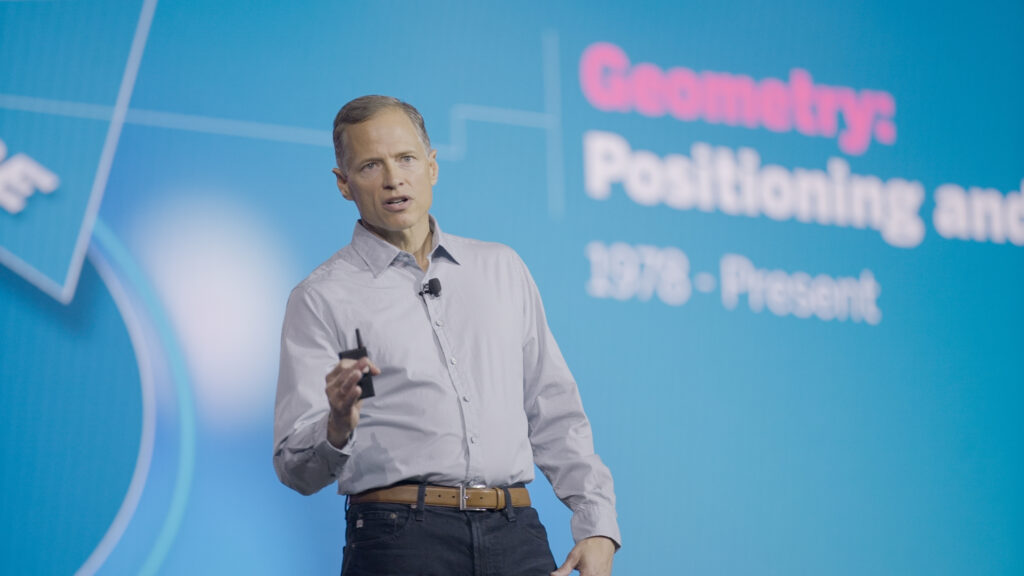
Rob Painter, Trimble’s CEO, promoted from CFO in 2020 to replace Steve Berglund, steers the opening plenary to a rousing start.
The attendance was 5750, of whom around 1000 were from Trimble (all the ones I encountered were helpful, friendly and very competent in answering my questions), from 62 countries – the largest Dimensions ever. The 400+ sessions featured 574 speakers, 296 of them customers. The anticipation as we filed into the hall on the first morning felt like the Esri or Hexagon shows – praise indeed!
CEO Rob Painter kicked off the opening plenary. He’s a clean-cut, boyish looking, energetic management type with an MBA from Harvard. He became CEO in 2020 – only the third in 44 years – and seems to be performing expertly. We don’t have time here to parade financial data, but the results undergird Rob’s confidence. He highlighted the Norwegian Public Roads Administration, which in August 2022 opened a 634 m bridge outside Oslo, built using 3D digital models, with data connected to each object, all without a single 2D drawing,. What are we going to spread on the hood of the pickup truck? The digital approach to the construction of this bridge resulted in cost savings of 10% – enormous in the construction world of low margins. Rob added the codicil, “This is what we do” and belted out three further achievements: a single human operating multiple machines on a site; SketchUp for iPad; viewing designs in AR. I liked his quote from Justin Trudeau’s speech in Davos in 2018, “The pace of change has never been this fast, yet it will never be this slow again.” Rob provided some news: Scott Crozier has recently taken over from Ron Bisio at the helm of Trimble’s survey and mapping organization; we’re into digital modeling of the Earth, not just geometry, i.e. intelligent model data rather than lines and polygons; a whole new MMS portfolio has emerged, spearheaded by MX9 and MX50; the program of focused acquisitions continues, the most recent entrants being E-Builder, ViewPoint, AgileAssets and B2W Software; stability and continuity of direction; the mission is to transform the way the world works; customer-centric innovation; connect and scale – Trimble industry clouds, such as Trimble Construction One. This last point was key and was emphasized throughout the event. Rob developed the theme and explained that it involves Azure and a close relationship with Microsoft. Big tech fans were overjoyed when Microsoft’s CEO, Satya Nadella, appeared on the screen to offer some words of welcome and encouragement. “Digital technology is the ultimate tailwind.” I was pleased that to his left there was an elegant book stack – books one on top of the other, on their sides, in the modern style – very like the one in my dining room…
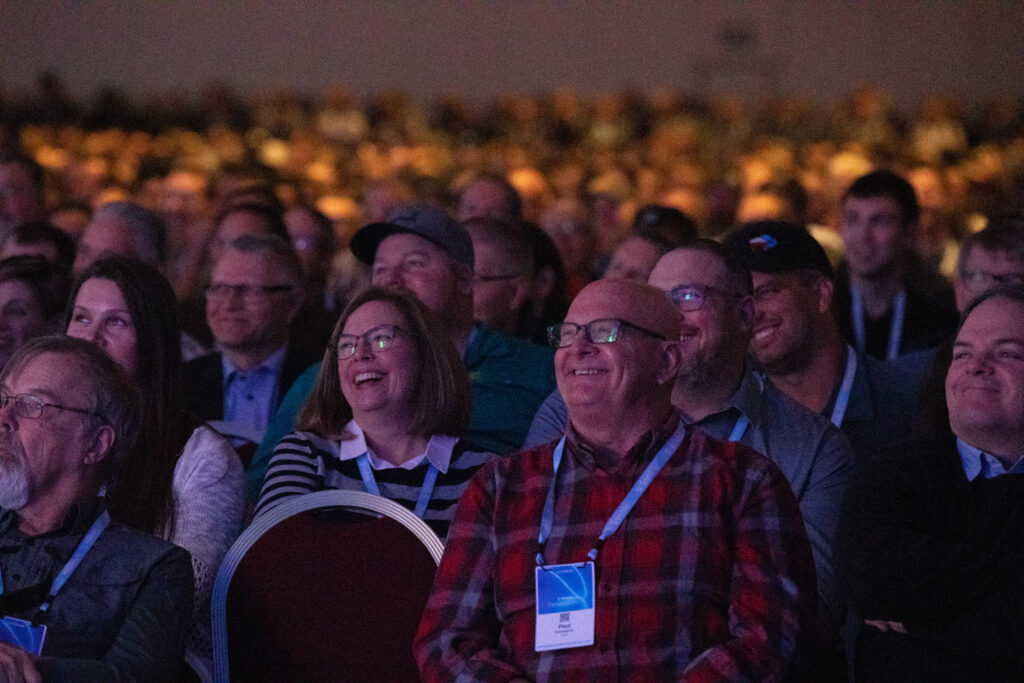
Keynote Audience.
Rob reiterated the cloud direction – the word “Trimbleverse” may pass into history, better used for an addendum to a hymn by some elderly English vicar – then we moved to the famous guest, Steve Wozniak, co-founder of Apple. He and Rob sat in armchairs, Rob gave short prompts and Steve expounded off the cuff. It was humorous, yet in places perceptive and informative, a great half-hour. It’s 16 years since publication of his book iWoz, but now I want to read it. “You want to be the disrupter, not the disrupted, and Apple was good at that.”
Saddled with the role of following Wozniak, Aviad Almagor, Trimble’s VP, technology innovation, performed bravely and well. He started with Trimble’s impressive list of firsts and described its engineering strengths. I liked his summary of progress: from isolated point solutions to an integrated platform. Aviad was compelling and wove technologies such as robotics, AI and quantum sensing into his presentation. Aspects of the “Trimble metaverse”, such as integration of the real and digital worlds, and the value of recent acquisitions, were repeated. Partnerships singled out were Boston Dynamics (Spot the dog), Nvidia and Volvo. It turns out that we studied for our MBAs at Heriot-Watt at the same time. We didn’t meet, because the instructional mode was distance learning. In a way, I’m glad: his intellect would have embarrassed me!
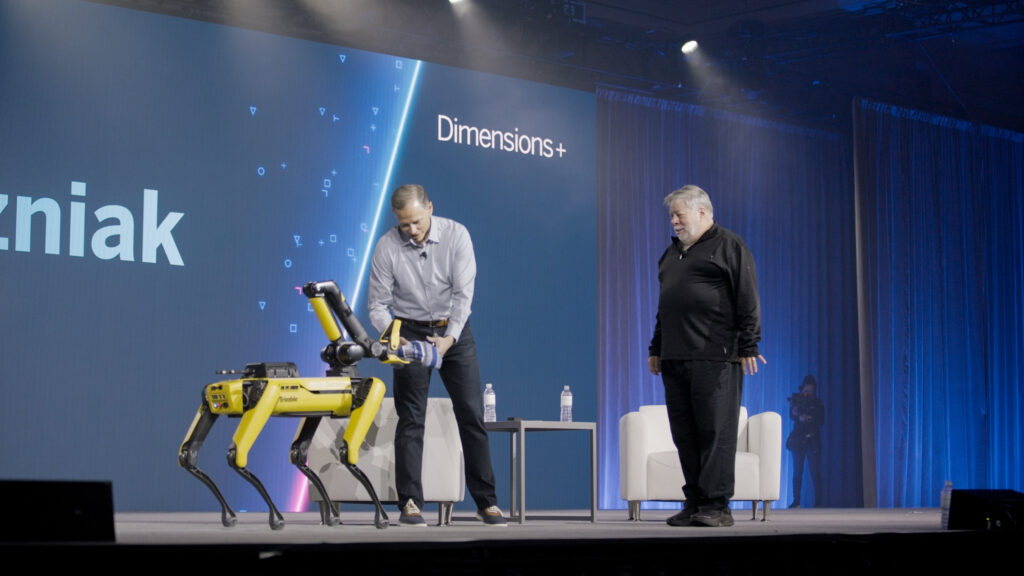
Steve Wozniak enjoys keynote discussion with Rob Painter, to the delight of the audience. Rob enlisted Boston Dynamics’ Spot the dog to help present Steve with a Trimble beanie by way of thanks.
After the break, I attended the construction plenary. The big attendance was unsurprising since construction represents 13% of global GDP. Various Trimble principals stressed new technologies as well as connectivity, exemplified by Trimble One Construction, “The connected solution suite that simplifies your technology stack and streamlines the way that you work”: built on Azure, open ecosystem, API-driven, standardized, secure data capture, real-time office-to-field connection, access to >40 Trimble applications spanning all aspects of the project; invite people, projects and data and bring them together, participate in workflows. Towards the end of this session, I learned a couple of things that brought home the reach and scale of Trimble’s operations: SketchUp Pro for iPad has more than two million users; and a product integration deal with Hilti was announced that will help contractors streamline tool tracking and job cost allocation.
The big geospatial session after lunch attracted an audience less than 10% of the construction one. Scott Crozier joined Trimble in 2000 after completing a mechanical engineering degree at the University of Canterbury in New Zealand. He started in agriculture, but then moved to construction. It took six visits and three years to persuade his father on the family farm near Christchurch to invest in Trimble technology! He reiterated the now familiar themes – merge digital and physical worlds; industrial metaverse; big data challenges; capturing, sharing, uploading massive data sets; connect and scale; be open; partner with key players in industry – then brought them to life by introducing management colleagues to describe examples. The goals in geospatial are continuous innovation of core products; workflows for verticals, e.g. tunnel lifecycle; enabling customers through the field-office-cloud-platform approach. VP survey and mapping strategy Boris Skopljak put it well, “Surveyors are the first to arrive on site, last to leave. We connect the digital and physical worlds. We are up to the challenge.”

Scott Crozier, appointed in 2022 as VP of Trimble’s survey and mapping organization.
Stephanie Michaud, strategic marketing manager, drew things together with some statistics about professional land surveyors’ high retirement rates coupled with the challenge of everything a new surveyor has to learn, but expressed confidence that today’s graduates can meet this. Trimble is in 153 countries, operates in 34 languages and has 386 distributors, giving the capability to localize to suit the way surveyors work. Like Scott, she spoke about the importance of the relationships with Autodesk, Bentley and Esri.
Meanwhile, the breakout sessions were in full swing. I attended a few, mainly about challenging laser-scanning projects, with audiences from a handful to more than 50. I’m trying to secure articles from some of the speakers. There were surveys and modeling of bridges, one on the supposed site of King Arthur and the Knights of the Round Table; one in Nottingham with severe covid restrictions; a rusty one carrying Amtrak at Vandenberg Space Force Base. A session on starting one’s own drone program was packed, with standing room only. There was a helpful presentation on when to use TLS, when to prefer MMS and another described interesting projects in Oklahoma. But one presentation sticks in memory: Raouf Ben Jemaa, director of engineering, who had come to Trimble through its acquisition of Mensi almost 20 years ago, addressed the topic, “Artificial intelligence : unlash the full potential of your point cloud with deep learning”. The context was very much the TLS systems. Raouf provided a concise, accessible summary of deep learning and outlined Trimble’s work in the area, including deployments in Trimble RealWorks 11.2 and 12.0. In addition to incremental improvements, ongoing work includes extension from TLS to MMS, computing at the edge, and “create your own AI”.
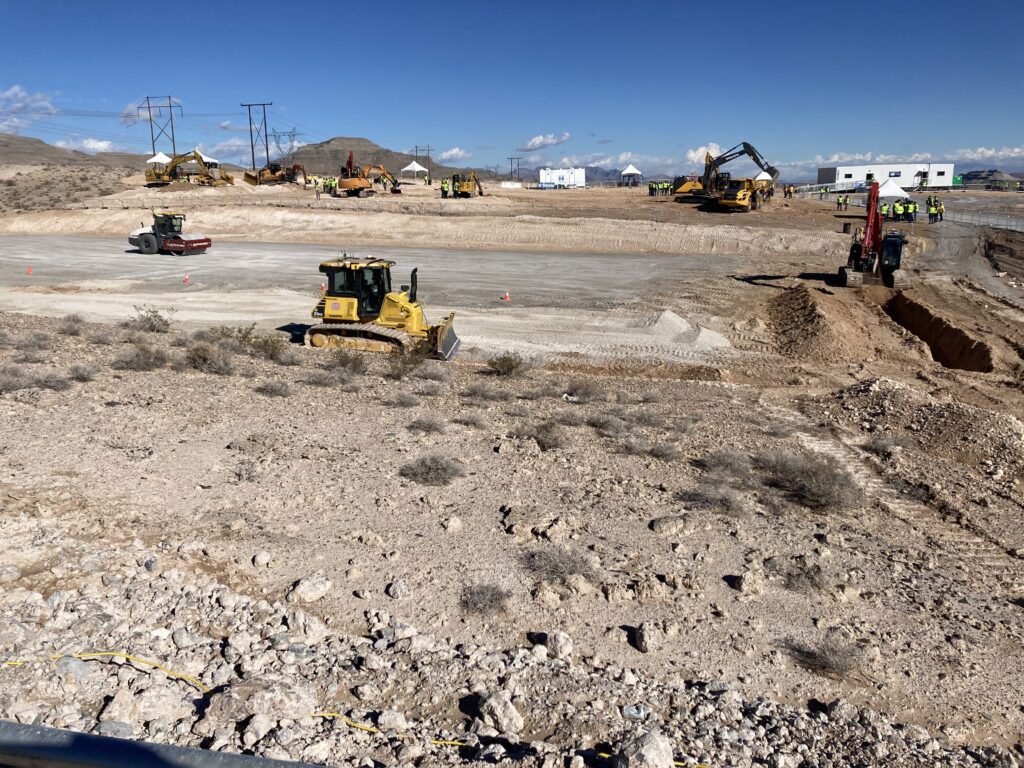
On the Tuesday morning, I spent time in smaller groups with Trimble folk and gain more insights into their thinking. Patricia Booth, SVP autonomy, opened proceedings at a press breakfast on autonomy with partner Dynapac, a Swedish machine supplier. Kevin Andrews, strategic marketing manager, explained that applications for construction machines are in some ways more complicated than for passenger vehicles. There is a progression from task automation through supervised autonomy to full workflow autonomy. There is worksite efficiency and machine efficiency. Autonomy on its own isn’t enough – integration is critical. The future is connected at all levels of autonomy. There followed a panel discussion on the benefits of autonomy and I was impressed at the realism: there is value now to be enjoyed even on the way to full autonomy; it is not necessary to implement complete autonomy for remarkable productivity benefits to accrue and, indeed, some customers are more comfortable if the innovations are deployed “a bit at a time” – it’s not “all or nothing”. Twenty years ago we were trying to add machine control and now 99% of bulldozers have automated blade control. Excavators too have many automated functions – so have compactors – and more will come. Construction is on the road to autonomy, with impressive benefits along the way. Operations with parallel passes, such as compaction, are highly suitable for automation: overlaps are reduced, providing benefits in productivity as well as reducing carbon emissions. Customer expectations have to be managed. One panelist pointed out that mining already involves substantial autonomy – but construction is not the same. In a world of high-cost projects and low margins, autonomy changes the economics, because at present it works better on some machines than others, but the costs of the machines aren’t the same. Managers have to think carefully about the systems they acquire or rent, then use, in order to maximize the benefits that are available. I could have listened to this for hours, but kept having to remember: GNSS, IMU, laser scanning and software are major components of automation, sensing not only the tasks to be accomplished but also the relationship between the machine and the site.
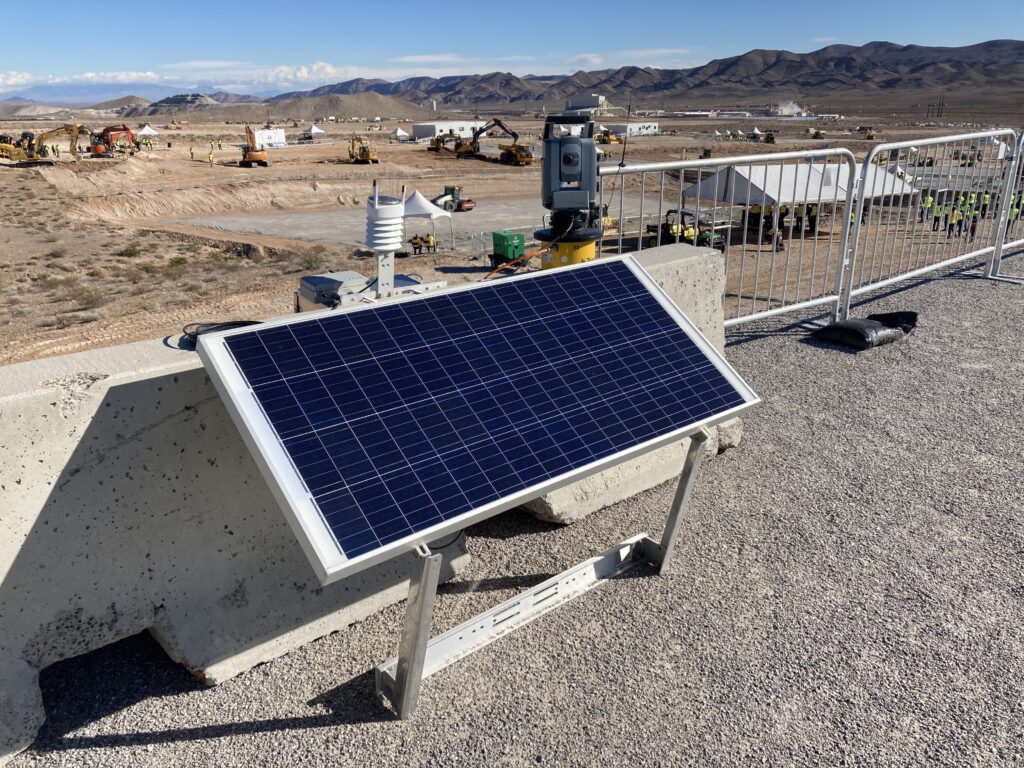
LIDAR Magazine was granted private sessions with Trimble leaders. Jacek Pietruczanis, business area director, a Pole based in France, had come to Trimble via the Ashtech-Magellan-Thales-Spectra Precision route. He agreed with my comment, based on what I had heard at Intergeo in Essen, that MMS had come of age, whether on a road vehicle or a rail trolley, but the price points of systems such as MX50 meant that they were still not universally accessible, though some customers started with entry-level systems and invested more as they gained experience. The MX50 had been launched in 2021 to complete the portfolio that already contained MX7 and MX9. The TLS portfolio had similarly been extended at the high end, with X12 joining X7 in 2022. Trimble therefore feels that the hardware portfolios are complete, so the focus is on customer experience, such as simplification of data processing. I asked whether there were any plans to add ground-penetrating radar to MMS: not as yet. The immediate future will involve more AI, especially for feature extraction, and data sharing in the cloud, following the themes presented in the plenaries. Data collection, contended Jacek, is no longer an issue, so the thinking must be on workflows – customer-centric, not product-centric.
The second interlocutor was Tim Lemmon, marketing director, based in Australia. As I spoke to senior Trimble folk, I came to realize that they are based all over the world: the company seems to be able to make remote working succeed and advance the philosophy and culture of the company despite the long distances and multiple time zones. Tim’s responsibility is geospatial software, not just products targeted at surveying, mapping, photogrammetry and remote sensing, but efforts to support other Trimble business areas. His responsibilities span products such as Trimble RealWorks for point-cloud processing and analysis, Trimble Clarity for publishing points-clouds to the Cloud, and parts of Trimble Connect, a cloud-based common data environment (CDE) and collaboration platform for construction. Tim stressed the increasing importance of IFC files. LIDAR Magazine readers know the Inpho suite, which is going strong and adding new capabilities, for example digital twins, meshes and true orthos. Inpho can be integrated into Trimble Business Center. Tim admitted there is a disconnect in the sense that many operations are still based on point clouds rather than meshes, though this is changing. Tim shared his colleagues’ opinions about how the survey profession is changing and that new surveyors will be able to handle and manage a remarkable range of hardware and software technologies.
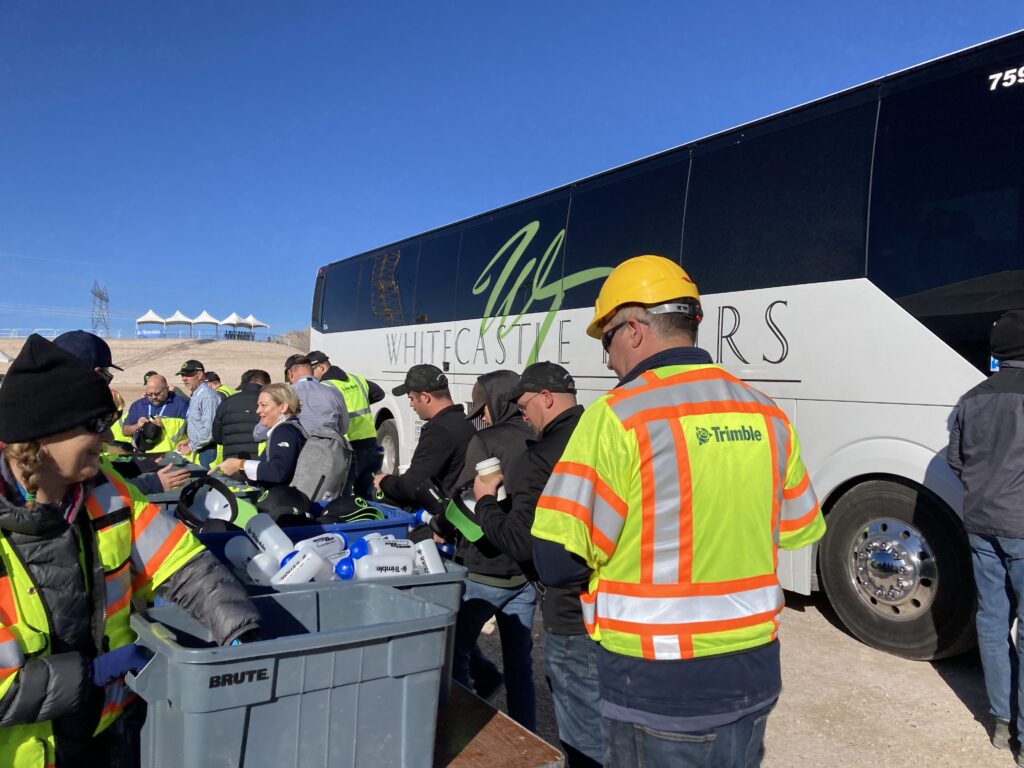
A memorable offsite. Media folk kitted out, then greeted by Trimble sector vice president Elwyn MacLachlan, before touring the site with guide Kevin Garcia.
I was bussed out to the offsite demos on the Wednesday morning. These were held at the site of the Southern Nevada Operating Engineers, with the construction machines being provided by Trimble partners. No-one could fail to be impressed by the 49 machines in operation, all automated to some extent and several completely autonomous. We were greeted by Elwyn McLachlan, sector vice president, who pointed out that Trimble supports more models of machine – and older generations – than its competitors. “Autonomy,” she said, “is the jewel in the crown”. A design can be pushed to a machine. This comes with challenges – the whole, end-to-end process has to be planned and programmed. The journey goes beyond autonomy to rich analytics. I had been wondering throughout the event about the role of Trimble’s recent acquisitions, so it was reassuring when Elwyn mentioned B2W Software. Elwyn passed us to Kevin Garcia, general manager, Civil Specialty Solutions, who proved an ace tour guide, taking us on an intense whistlestop of the site, keeping an eye on safety while describing what we were seeing, and answering all questions. Great stuff.
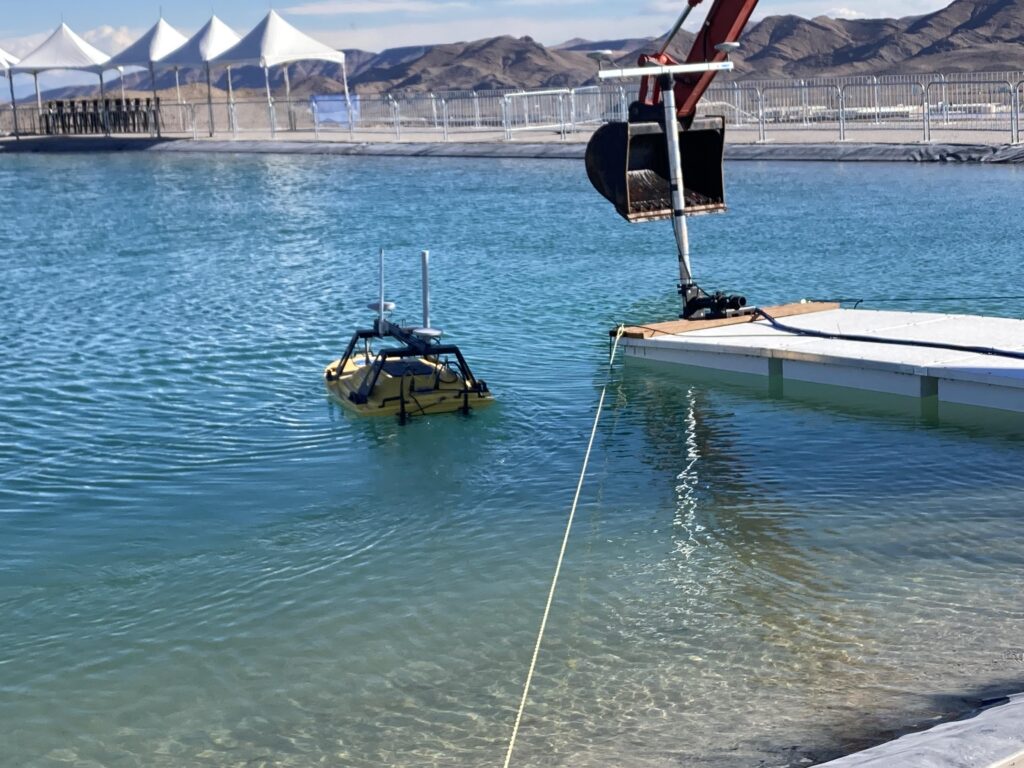
“Autonomy is the jewel in the crown” – submersible rover.
We started with a huge dredger at the edge of a pond, then were given the chance to operate an ASV. Right at the top of the hill was a monitoring station, complete with hardware, software and sharing, then we passed into the main area of the site to see the construction machines. I felt sorry for an autonomous excavator: as it dug a trench, an autonomous bulldozer filled it and the excavator had to repeat! There was a compactor making multiple passes, exactly as I had learned at the autonomy breakfast the previous day. We saw an R12 in operation. How wonderful that it’s no longer necessary to hold the pole vertical! With all the automation, we are in the world of the one-man crew – a productivity nirvana, albeit oxymoronic! I was there long enough to be impressed by Trimble’s range and by the expertise and enthusiasm of its people, but not long enough to understand every hardware and software product on show, which would have taken a day or two. We ended at a very noisy piling machine. A major application these days is solar farms, for which it is critical to have the rectangular steel piles driven not only in the right places but exactly parallel to each other, so the solar panels can be bolted on without delay. I asked Kevin about the market penetration of machine control and he reckoned about 25%: Trimble is performing brilliantly in these markets, but there is plenty yet to conquer.
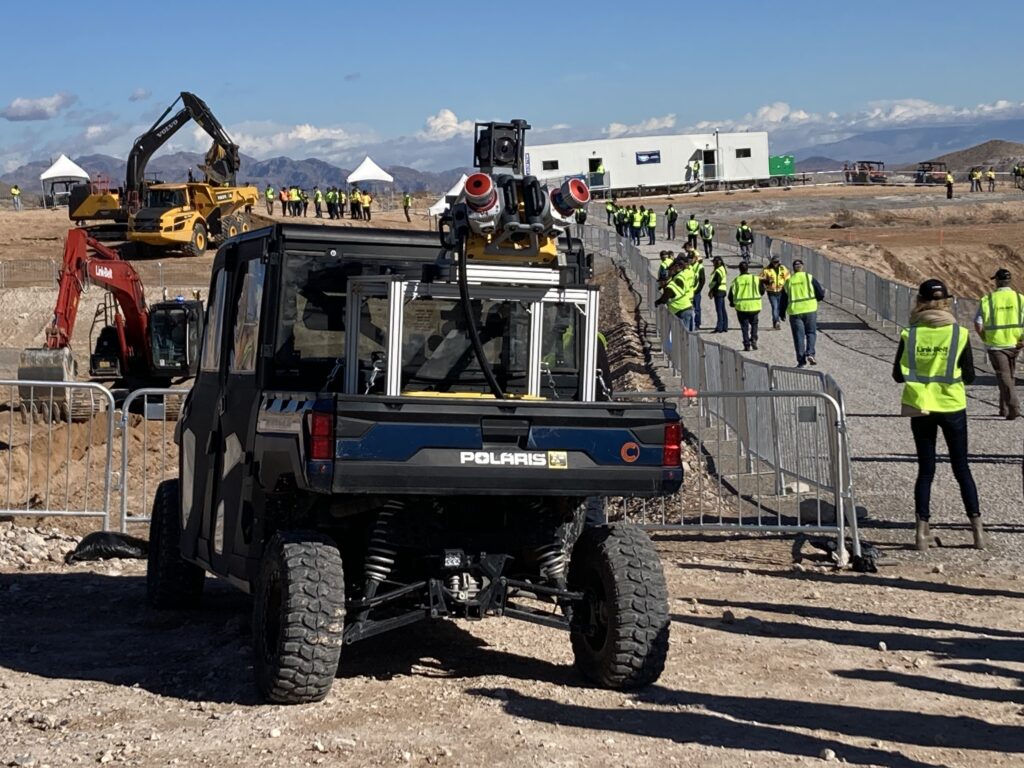
Offsite Las Vegas – note rugged MX Mobile Mapping System atop Polaris off-road vehicle.
The delegates I met at lunches and on the bus from the offsite were content, certain that their investment in the event had been worthwhile. I spoke to some from construction who were taking software training courses and were happy with the instruction. Nevertheless, one brought me back to earth by complaining that labor shortages plague the construction industry, even for operating the latest powerful machines equipped with Trimble gadgetry.
We left Las Vegas stuffed with fine food and intriguing information. Trimble is prospering and continues to stress the importance of communicating its innovations to the community. Rob Painter has successfully stepped into the shoes of Steve Berglund and is proving a safe pair of hands. While autonomous bulldozers and excavators are certainly Trimble’s forte, we in the LIDAR Magazine community should be delighted that the company, while recognizing that the geospatial world is tiny compared to construction and some of the other verticals in which Trimble prospers, emphasizes that geospatial people and technology are central to these markets’ success. As a result, it continues to develop a fine range of sensors, especially TLS and MMS laser scanners, underpinned by increasingly broad software offerings, which are now changing direction towards sharing and collaboration in the Cloud. Trimble proceeds with its series of well-judged acquisitions, resulting in skills and technologies that not only plug gaps but enhance and broaden the product portfolio. Long may it continue.